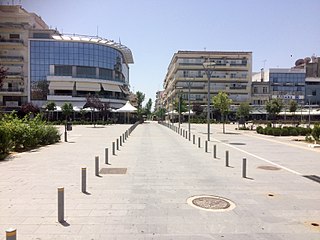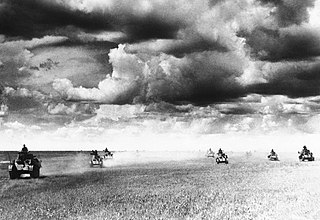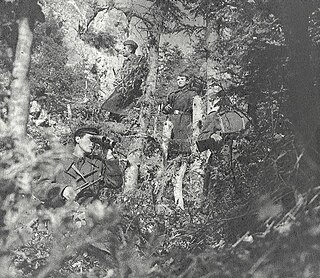
Orestiada, is the northeasternmost, northernmost and newest city of Greece and the second largest town of the Evros regional unit of Thrace. Founded by Greek refugees from Edirne after the Treaty of Lausanne when the population exchange occurred between Turkey and Greece, in which the river Evros became the new border between the two countries. The population is around 20,000.

The 2001 Bangladesh–India border clashes were a series of armed skirmishes between India and Bangladesh in April 2001. The clashes took place between troops of the Bangladesh Rifles (BDR) and the Indian Border Security Force (BSF) on the poorly-marked international border between the two countries.

The Soviet–Japanese border conflicts, also known as the Soviet-Japanese Border War, the First Soviet-Japanese War, the Russo-Mongolian-Japanese Border Wars or the Soviet-Mongolian-Japanese Border Wars, were a series of minor and major conflicts fought between the Soviet Union, Mongolia and Japan in Northeast Asia from 1932 to 1939.
After the 1978 Vietnamese invasion of Cambodia and subsequent collapse of Democratic Kampuchea in 1979, the Khmer Rouge fled to the border regions of Thailand, and, with assistance from China, Pol Pot's troops managed to regroup and reorganize in forested and mountainous zones on the Thai-Cambodian border. During the 1980s and early 1990s Khmer Rouge forces operated from inside refugee camps in Thailand, in an attempt to de-stabilize the pro-Hanoi People's Republic of Kampuchea's government, which Thailand refused to recognise. Thailand and Vietnam faced off across the Thai-Cambodian border with frequent Vietnamese incursions and shellings into Thai territory throughout the 1980s in pursuit of Cambodian guerrillas who kept attacking Vietnamese occupation forces.

This is the timeline of the Turkish-Kurdish conflict. The Kurdish insurgency is an armed conflict between the Republic of Turkey and various Kurdish insurgent groups, which have demanded separation from Turkey to create an independent Kurdistan, or to have autonomy and greater political and cultural rights for Kurds in Turkey. The main rebel group is the Kurdistan Workers' Party or PKK, which was founded on November 27, 1978, and started a full-scale insurgency on August 15, 1984, when it declared a Kurdish uprising. Apart from some extended ceasefires, the conflict has continued to the present day.
The 2010–2012 Myanmar border clashes were a series of skirmishes between the Tatmadaw on one side, and the DKBA-5 and the Karen National Liberation Army (KNLA) on the other. The clashes erupted along the border with Thailand shortly after Myanmar's general election on 7 November 2010. An estimated 10,000 refugees have fled into nearby neighbouring Thailand to escape the violent conflict. There was concern that due to discontent with the elections, and speculations of electoral fraud, that the conflict could escalate into a civil war.
2003 in Afghanistan. A list of notable incidents in Afghanistan during 2003
September 2012 southern Israel cross-border attack refers to an incident on 21 September 2012, when three Egyptian militants, wearing civilian clothes and armed with explosive belts, AK-47 rifles and RPG launchers, approached the Egypt-Israel border in an area where the Egypt–Israel barrier was incomplete, and opened fire on a group of IDF soldiers supervising the civilian workers who were constructing the border fence.

Following the outbreak of the protests of Syrian revolution during the Arab Spring in 2011 and the escalation of the ensuing conflict into a full-scale civil war by mid-2012, the Syrian Civil War became a theatre of proxy warfare between various regional powers such as Turkey and Iran. Spillover of the Syrian civil war into the wider region began when the Iraqi insurgent group known as the Islamic State of Iraq (ISI) started intervening in the conflict from 2012.
The following is a timeline of the Syrian Civil War from January to April 2019. Information about aggregated casualty counts is found at Casualties of the Syrian Civil War.

The Greece–Turkey border is around 200 kilometres (120 mi) long, and separates Western Thrace in Greece from East Thrace in Turkey.

The 2019 Turkish offensive into north-eastern Syria, code-named Operation Peace Spring by Turkey, was a cross-border military operation conducted by the Turkish Armed Forces (TSK) and the Syrian National Army (SNA) against the Syrian Democratic Forces (SDF) and later Syrian Arab Army (SAA) in northern Syria.

The Second Northern Syria Buffer Zone, part of the Sochi Agreement, is a buffer zone in northern Syria between the Turkish Armed Forces (TAF) and the Syrian Democratic Forces (SDF). It was set up following a memorandum of understanding in the Russian city Sochi on 22 October 2019 by the Russian and Turkish presidents during the 2019 Turkish offensive into north-eastern Syria. Most of the zone is controlled by the Syrian Army and Russian Military Police, and some by the TAF.
On 27 February 2020, during the Dawn of Idlib 2 Operation, a joint airstrike was executed by the Russian and Syrian Air Forces against a convoy of the Turkish Army stationed in Balyun, within the Idlib Governorate. Turkish President Recep Tayyip Erdoğan reported that the assault resulted in the loss of 36 Turkish soldiers. However, alternative sources suggested a significantly higher death toll, ranging from 50 to 100 casualties, marking it as the most lethal attack on Turkish forces since their engagement in the Syrian Civil War commenced. The assault also inflicted injuries on an estimated 36 to 60 soldiers, with 16 of them reported to be in a critical state. This incident represented the most substantial loss of life experienced by the Turkish Army on foreign territory since the Turkish invasion of Cyprus in 1974. In response to this attack, the Turkish Armed Forces initiated Operation Spring Shield in the province of Idlib.
The following is a timeline of the Syrian civil war for 2020. Information about aggregated casualty counts is found at Casualties of the Syrian civil war.
The following is a timeline of the Syrian civil war for 2021. Information about aggregated casualty counts is found at Casualties of the Syrian civil war.
The following is a timeline of the Syrian civil war for 2022. Information about aggregated casualty counts is found in Casualties of the Syrian civil war.

The events at the Greek-Turkish border along the Evros river in 2020 began on 28 February 2020 when the Turkish government announced that in response to the death of 33 Turkish soldiers in Idlib, it was unilaterally opening its borders to Greece to allow refugees and migrants seeking refuge to reach the European Union.
On 20 November 2022 the Turkish Air Force launched Operation Claw-Sword, a series of airstrikes against Syrian Democratic Forces and Syrian Army positions in Northern Syria and against Kurdistan Workers' Party (PKK) positions in Northern Iraq. The airstrikes were launched following the 2022 Istanbul bombing on 13 November, that the Turkish government say was conducted by Kurdish separatists.

The Albanian–Yugoslav border conflict, was a period of armed confrontations between the armed forces of Albania and Yugoslavia between the years 1948 and 1954. This period of heightened tensions between Albania and Yugoslavia stemmed from territorial disputes and ideological divisions between the Yugoslav Leader Josip Broz Tito and Albanian Leader Enver Hoxha. During the Cold War period, the border between Albania and Yugoslavia became one of the most contentious in the Eastern Bloc.









